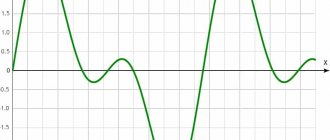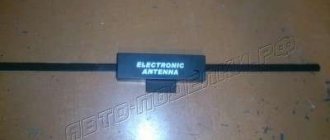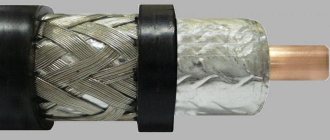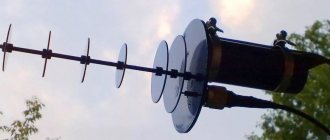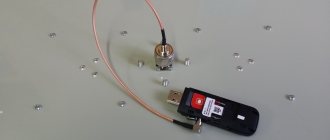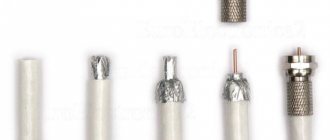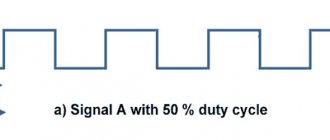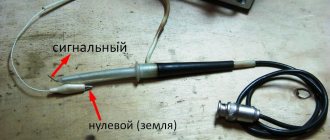Today you rarely find an apartment with only one TV. Usually there are two or even three. And the subscriber has a question about how to connect all devices to one antenna cable. It would seem that an elementary tee splitter will allow you to send a signal to three digital broadcast TVs. In practice this is not always the case. A divider or splitter for DVB T2 digital television must be selected in accordance with the structure of the cable network in the house.
Types of splitters and their areas of application
A digital TV signal splitter performs the task of matching circuits when connecting two consumers to one source . There are several types of such devices with different recommendations for use.
- A linear antenna divider for digital terrestrial television evenly divides the signal into several consumers. At the same time, depending on the quality of the device, the level drop rate ranges from 1.44 to 2 and higher (for two TVs). A line splitter can have several outputs and only one input. So, a crab splitter can connect three TVs at once.
- An antenna splitter for digital television works differently. At one of its outputs, it generates a signal with nominal values, the strength of which depends on the input parameters. Roughly speaking, the rest of the pie is sent to other consumers. And the more there are, the lower the signal level at each.
- The adders work in reverse order. They have several inputs and one output. Such a device allows you to coordinate signals from a group of antennas and direct them to one consumer.
Splitters and splitters are divided according to their operating range. Devices with frequencies up to 1000 MHz are better for cable TV and digital terrestrial signals. They are inexpensive and available in a huge number of models from different manufacturers. Products with operating frequencies up to 2400 MHz show good results when processing satellite TV.
Splitters can be active or passive. The latter greatly reduce the signal level and are not able to provide the declared characteristics at low input parameters.
Device settings
When choosing, you need to take into account the technical parameters of the device:
- The attenuation level indicates how much the signal transmission power through this device is reduced. The smaller this value, the better the device works.
- A splitter is designed to distribute the incoming signal between several television receivers. Typically the number of recipients is from two to eight. It is important that the number of outputs corresponds to the number of pieces of equipment. There are also splitters for 16 recipients, but such models are relatively rare.
- Bandwidth characterizes the frequency range used. In most cases, for terrestrial television it is 5-1000 MHz, and for satellite television it is 5-2500 MHz.
- An active antenna splitter additionally uses an amplifier. It is capable of providing increased power during signal transmission. Such devices are more expensive and can work with no more than two devices.
When choosing a splitter, its parameters must correspond to the specific situation of the buyer. If not all connectors will be used, it is recommended to install plugs on the remaining ones.
The device indicates the degree of signal attenuation for each connector Source stroy-podskazka.ru
How to choose a signal splitter
As mentioned above, the splitter and splitter of the digital TV signal are selected, first of all, by operating frequency. With parameters up to 1000 MHz, they are unsuitable for satellite TV. And more expensive ones mean that the user will waste money. The second obvious parameter is the number of consumers. The splitter is selected according to the number of outputs corresponding to the number of TVs in the apartment.
The need to purchase an active divider is assessed based on the length of the cable network in the house . It will not be superfluous to take into account the antenna parameters. The criteria for choosing a splitter are quite simple.
- With an active antenna and a short length of lines, it makes no sense to spend money on a divider with an amplifier. All consumers will have sufficient signal level.
- An antenna with an amplifier and a significant length of lines also do not require the purchase of active splitters. But in extremely remote points of the cable network, the signal strength may be insufficient for a high-quality picture on some channels. In this case, it is cheaper to install a personal amplifier on such a consumer.
- A passive antenna with a short line length will force you to pay attention to the splitter parameters. If the receiving device provides an output signal level equal to or greater than the recommended input parameter of the divider, passive splitters can be installed. Otherwise, you will have to buy a more expensive active device.
Finally, with a passive antenna and long cable lines, you simply cannot do without an active signal divider. In this case, problems with the picture and search for individual channels are practically guaranteed for all consumers. However, the antenna and line combinations described above are too ideal to be encountered frequently in practice. Therefore, dividers must be selected paying attention to the physical structure of the cable network.
Do I need an amplifier?
If you need to connect several TVs to one antenna at once, you need to keep in mind: using a splitter of any design, the signal is still divided in half, and if 3 tuners are connected, then each gets only a third. Therefore, in most cases you need to connect an amplifier.
It will definitely be needed in situations where:
- the signal has good quality, but low power;
- two or more splitters are installed;
- long connecting cables are used.
In addition, the amplifier will most likely be superfluous when using cable and satellite TV. For them, the main thing is not to degrade the incoming signal, and the amplifier inevitably introduces distortion.
Finally, if the signal is critically weak, the amplifier is useless. It will not be able to raise the TV signal received by the antenna to the required level: there is simply nothing to amplify.
Installation Rules
The rules for installing dividers on two, three or more digital broadcast televisions are based on the structure of the cable network. It can always be considered as a collection of several segments with one of two standard types.
Equilibrium structure
The most clear example of a balanced network is an antenna installed on the roof and cable routing through the ceiling of the top floor of the house. In this case, the length of the leads to the consumers is almost the same. This means that it is enough to install dividers to evenly distribute the signal between TVs.
Bonus: we connect 2 TVs without adapters
According to amateur TV experts, in some cases adapters in the form of dividers are not only unnecessary, but even harmful.
Experts suggest the following scheme:
- An antenna and two coaxial cables are taken.
- The ends are trimmed. The distance at which the top insulation needs to be removed is determined experimentally.
- The braid and foil of the cables are unraveled and a general twist is made from it. The central wires remain separate.
- These two wires are fastened with screws to a regular place in the antenna. A twist of shielding material is attached in the same place where the shield of a single cable should normally be located. The main thing is to ensure that the cores do not come into contact with the screen.
However, it is technologically more difficult, in addition, it changes the characteristics of the circuit in an unpredictable way, so you can use this connection option, but the result is not guaranteed.
How to avoid a drop in signal level when installing a splitter
With a high-quality antenna and two TVs in the apartment, the user may not notice any problems after installing a simple splitter. However, in a large house there will definitely be network points where the drop in signal level at dividers and splitters will be excessive. There are several ways to avoid problems.
- Installation of passive signal amplifiers. They are mounted in front of the consumer and do not require power. The devices compensate for wave losses in the cable and are indicated when there are reception problems only on certain channels.
- The use of active amplifiers. They are also installed in front of the TV. Devices of this class produce an increase in signal level and are indicated in situations where the picture freezes on all channels, the required 20 digital broadcasts are not detected when searching, and other serious problems arise.
It is always worth remembering one thing: the more splitters, splitters, signal amplifiers in the network, the higher the distortion will be . To optimize the level of losses, it is highly recommended to reduce the length of lines, use a minimum number of switching points with F-connectors, and lay the cable away from 220V power wiring and other sources of interference.
If you only have one TV connected in your house, then there are usually no problems. In this case, the television signal enters the television receiver directly from the antenna. The problem comes when you want to watch two or more TVs. You don't have to buy a separate antenna for each of them. A TV cable splitter will come to the rescue - a small-sized device that will completely solve this problem.
The “magic” foreign words “splitter” and “diplexer” are called, respectively, an ordinary antenna splitter for digital television or a combiner of two different signals. Among cable operators, these devices are often referred to as “crabs.”
Using dividers in an apartment
It is necessary to pay attention to the location of devices inside the apartment. The installation rules depend on the connection structure. It can be equilibrium or nonequilibrium. It is convenient to illustrate this with the following example.
The television signal enters the apartment via one cable. The receivers are at the same distance from him. In this case, you can use a simple divisor. Which will divide the input signal into several identical ones.
If the TVs are located at different distances from the input cable, the connections will have different lengths. Thus, the closest signal will be of the highest quality, and the most distant signal will be of the least quality. There is a nonequilibrium structure here.
In this case, a coupler is used that will split the signal into two, one of which is strong and the other relatively weak. The last one is for the nearest TV receiver, and the other is for the next coupler. This scheme will allow you to get maximum video and audio quality on all available devices. Splitters will allow you to redistribute the power of the input signal.
When using a splitter, you must choose a suitable location for it. It is important to keep the cable length to a minimum. When using three or more TVs, the signal is expected to become quite weak. This will allow you to watch analogue channels, but not digital ones.
For the latter, high signal quality is critical. In this case, it is recommended to use an active splitter. It will enhance the input signal to the required extent. It should be taken into account that signal amplification can also be done immediately after the antenna.
The more outputs the divider has, the stronger the attenuation will be. Therefore, it is not recommended to purchase a device that has more sockets for connection than necessary. If there are only two TVs, it is not recommended to take the device for 3 or more television receivers. When using it, not only signal weakening can occur, but also image ghosting. The latter is due to the presence of empty connectors. To avoid this effect, a plug with a resistance of 75 Ohms is placed on the free connector, which simulates a connected load.
What is an antenna divider?
As the name suggests, an antenna splitter is a device consisting of a compact metal housing with several cable connectors, which serves to distribute the signal to several receivers. Not all splitters perform the same function, so they are grouped together.
Dividers (splitters)
The TV signal is evenly distributed to the required number of outputs. Indispensable in home cabling. The most popular type of television accessories among consumers. The main dividers that can be found in stores.
- From 5 to 1000 MHz – used for analogue cable and terrestrial digital television.
- From 5 to 2400 MHz (with power pass) – used mainly for satellite TV.
Couplers
Sometimes the signal needs to be divided so that the main part of it is sent to one output (OUT), and the small remaining part is sent to a tap (TAP), where the signal will be much weaker than at the main output, where the main part goes. In the future, the same coupler can be connected to this main output, and the signal quality will not be lost. This type of divider is used in daily practice by cable TV providers when installing multi-apartment television networks. A band blocker or cable plug, a type of tap, works on the same principle, which can be useful when separating free and paid channels.
Adders (diplexers)
Of practical interest is an antenna divider capable of conducting a signal in the opposite direction and thus summing it. Combiners are able to mix signals from several wave receivers with different frequency characteristics into one cable. That is, you can sum up satellite and cable or digital television.
Making a connection
Please note the following when connecting cables:
- If the device has coaxial jacks, then you can connect any type of cable to them using regular antenna plugs.
- When threaded connections are present in the splitter, it is assumed. That the connection will be made using a thin cable.
- For screw terminals, any type of cable can be used.
In order to make a connection, you must perform the following steps:
- Secure the splitter using the chosen method. This can be done by mounting it on the wall, fixing it on the TV receiver mounts, in a special niche, or in a plastic box.
- The rivets must be removed from each splitter connector.
- Cables from TVs are connected to the corresponding sockets.
- Insert the antenna cable.
After this, you can start viewing available programs. After installation is complete, you need to check the image quality. If it is not high enough, it is recommended to use a more powerful antenna, or use an active TV divider.
Active or passive?
From the point of view of electrical parameters, a TV splitter can be passive or active. The first simply splits the signal into two or more outputs, with the significant advantage that it does not require an external power supply. If the incoming signal is strong enough, passive dividers work great without amplification, especially if it is a two-output splitter.
An active splitter is identical in design to a passive one, but differs in the presence of a small built-in amplifier, the task of which is to compensate for the loss of air quality caused by the separation. Splitters with an amplifier require a power supply for the chip. The range of these devices is represented by dividers with the ability to pass the supply voltage. This type of splitter is used when the incoming signal is uncertain or the antenna cable to the TV is long.
Price overview
As an example, we chose the Luxmann SP-202 splitter, which allows you to connect two TVs to one antenna cable.
| City | Cost (USD) | City | Cost (USD) |
| Ekaterinburg | 4 | Penza | 4,2 |
| Krasnoyarsk | 4,1 | Minsk | 4,1 |
| Moscow | 3,8 | SPb (Petersburg) | 3,85 |
As can be seen from the table, the price of an antenna splitter in Moscow, Krasnoyarsk, Minsk and other cities does not vary much. How economically profitable it is to make it yourself or buy it is up to you to decide.
How do dividers work?
Don't even think about simply connecting two parallel cables to the antenna and getting another signal source. Is it really not possible to connect antenna cables in a simple way? The law doesn't prohibit it, but it's impossible.
An antenna cable, like any other, has a characteristic called “wave impedance.” The cable has its own characteristic impedance, calculated by the designers, so it should only be connected to an object that has the same characteristic impedance. Any attempt to connect the cable “to just about anything” leads to the fact that the main part of the signal, having reached the end of the cable, does not arrive at an object with a different characteristic impedance value, but instead is reflected and goes back along the coax.
The signal will not travel from the cable to an object with the “wrong” characteristic impedance. That is why, instead of a primitive, incorrect connection in the form of twisting, you need to use a coaxial cable splitter, or an antenna signal combiner, with a well-calculated characteristic impedance, the same as that of the cable. Unfortunately, the output signal divided into several receivers has a slightly reduced level.
Knowing how your divider works will help reduce troubleshooting time. For example, if the picture on the screen is torn, it is advisable to start searching for the causes by diagnosing faults in the signal source. You need to check the cable connectors of the splitter and the cable insulation. No metal parts of the cable shield should touch the cable core or clamp.
Principle of operation
At first glance, it may seem that you can directly connect several output cables to an input cable. In fact, although this will work, it will make the signal so low quality that it will be impossible to watch.
The fact is that each cable has a certain characteristic impedance. They will be different for the input and output. If they are connected to another using twisting, then part of the signal will pass through it, and most of it will be reflected. The device is designed in such a way that the loss of quality during transmission is minimal. An active antenna TV splitter can completely compensate for the loss of signal quality.
How to choose the right splitter for TV
When buying a TV antenna splitter, the first thing you need to pay attention to is the number of output ports. If there are three television receivers in the house to which you want to connect the television signal and divide it, then, of course, you will need a splitter with three outputs. This is its main visual characteristic and you can hardly go wrong. A reasonable solution would be to buy a divider with an additional output, so to speak for the future.
Domestic and foreign manufacturers supply the market with a lot of splitters, from a double divider to a 16-port splitter. Their housing contains markings indicating the operating frequency range and the designation of inputs and outputs. Check whether the selected microdevice supports the required frequencies? The most common operating range is 5-860 MHz, which makes it easy to distribute a DVB-T2 television signal while maintaining broadcast quality. The channel frequency display function on your TV will help you not to make a mistake with the frequencies. The maximum frequency of one of the channels must fall within the frequency range of the divider.
- A criterion such as attenuation also deserves attention. Its parameters are indicated in decibels on the device body or in its instructions. Of the two suitable splitters, choose the one with the lower attenuation value.
- You already know about active and passive dividers. When purchasing an active model, your task is to decide on the type of power source (regulated or not) and make sure there is an outlet in the chosen location.
- Dividers vary in the way the cable is connected. You can find devices with screw terminals (works with any cable diameter), with threaded connections, with coaxial connectors, and those where the cable needs to be soldered.
Selecting a TV cable
You should be very careful when choosing a television cable. The wire largely determines the quality of the television image on televisions remote from the main antenna input. All types of TV cable have a standard characteristic impedance value. It is 75 ohms.
However, different types of cable have different attenuation. Its value is not indicated directly on the cable. The attenuation value can be found on special websites on the Internet. The attenuation of a cable, or rather its specific attenuation, is expressed by a number with the dimension dB/m. The most suitable will be the one with this value the smallest compared to the others.
The longest sections of cable routes laid in an apartment have the greatest attenuation. If you do not prepare for the purchase in advance, then if you have a choice, you should buy the cable that has the largest diameter of the outer sheath. It has less attenuation compared to others.
Purpose and main differences
Splitters (dividers)
allow you to evenly divide the television signal between several outputs. For example, if the input signal level was 12 dB, then at the outputs of a double divider it will be 6 dB, a triple divider - 4 dB, and a quad divider - 3 dB.
Double splitter
The figure shows a schematic representation of a double splitter, where:
Antenna splitters of this type are used in cases where it is necessary to send a signal to 2 or 3 TVs, or more if the device has an amplifier (active splitter).
Adders (diplexers)
allow you to combine two signals into one. Most adder models are universal; they can work in two directions, that is, act as an adder or a divider.
Double adder
The figure shows a schematic representation of a double diplexer, where:
- A and B – input signals;
- C – output signal
A combiner (diplexer) is used in cases where it is necessary to send signals from a satellite and a conventional antenna through one cable or to combine signals from different ranges.
Couplers
They are used to organize a backbone television network, for example, to divert a signal to apartments in a multi-storey building.
Double tap Line organization diagram
The figure shows an example of organizing a highway using several taps, where:
- A – incoming signal;
- B, C, D, E, F, G, H, I, J – signal output (tap), for example, to each floor of a nine-story building.
As can be seen from the connection diagram, such devices have one pass-through output, from which the signal is supplied to the input connector of the next coupler.
Antenna splitters can also include a range blocker (stub), which is widely used by cable television operators to separate social and paid connection packages.
In everyday life, splitters are most often used; they are used to connect several televisions to the antenna cable entering the apartment; the quality of the television signal directly depends on these devices.
Do it yourself
It’s not difficult to make a splitter for analog television with your own hands; here are some simple diagrams of such a device.
Passive splitter with resistors.
Separator circuit for two and three devices
The figure shows two diagrams:
- a – for connecting two TVs (R1, R2, R3 = 25 Ohm);
- b – for connecting three TVs (R1, R2, R3, R4 = 36 Ohm).
Below is an example of a printed circuit board layout for circuit “b”.
Splitter board for three devices
The assembled device must be placed in a special case (any metal box will do for this), which should preferably be grounded. If the grounding is incorrect, interference in the form of snow may occur. Actually, it is better not to ground at all than to do it incorrectly.
If the image on the TV screen is double, you should put a ferrite ring on the coaxial cable between the splitter and the TV.
Active splitter circuit.
In cases where you have a low level of the incoming television signal, you can correct the situation using a divider that has a broadband frequency amplifier. The diagram of such a device is shown in the figure below.
Divider circuit with antenna amplifier
Parameters of the elements indicated in the diagram:
- R1-10 Ohm;
- R2, R4, R5 – 430 Ohm;
- R3 – 30 kOhm;
- R6 – 150 Ohm;
- R7 – 470 Ohm;
- R8-R10 – 43 Ohm;
- C1, C2, C4 – 150 pF;
- C3 – 0.01 µF;
- VT1 – VT2 – KT399A;
Choke L1 is a frameless coil wound with PEV-2 wire with a cross-section of 0.4 mm, the diameter of the coil is five millimeters, there are 4 or 5 turns.
You can use batteries to power the circuit, but it is better to take a power supply for this. In the latter case, the transformer may create interference, so it is advisable to place the power supply in a separate housing. That is why it is advisable to install the splitter in a wireless zone, that is, where there is no electrical wiring.
Note that the above antenna splitter circuits have proven themselves to be effective in dividing analog signals; as for satellite and digital television, it is better for them to buy a ready-made device than to make it yourself.
How to choose a splitter, adder, coupler
First of all, it should be taken into account that the operating frequency of antenna splitters for digital television and satellite dishes is different. For the former it is limited to 1 GHz, for the latter it is 2.5 GHz. In addition, the satellite splitter may have a “Powerpass” function (allows you to supply power to the satellite dish head).
Note that a satellite splitter can also be used to split a digital or analog signal.
The second parameter that you should pay attention to is signal attenuation; as a rule, its value is indicated on the device body; the lower it is, the lower the losses.
It is also important who the manufacturer of the device is. Products from such well-known manufacturers as: Alda, EUROSAT, MATRIX, etc. will give an output signal an order of magnitude better than Chinese or homemade splitters.

